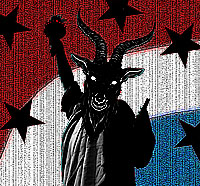It seems even the Aussie chattering class are starting to worry about where this multicult, diversity Frankenstein experiment is going. Rosemary Neill, “Nation Divided at School Gate as Progressives Lead White Flight,” The Weekend Australian, December 10-11, 2016, p. 1, is one example. And here is the opening paragraph: “Since 2002 the City of Yarra council has proclaimed Melbourne’s inner north “a Refugee Welcome Zone.” But in this ardently Greens-voting area – and in left-leaning suburbs in Sydney’s inner west – progressive, middle-class families have been accused of avoiding schools with high refugee, indigenous or non-English-speaking student populations.”
The White progressives are “fleeing” inner Melbourne schools that have large African-Australian populations. Indeed, one academic quoted observes that the White progressives’ acceptance of diversity does not apply to their own children. But it is not just Whites that are engaging in ethnic segregation the article says, as “staggering” levels of separation are also found in “predominantly Asian selective government schools on Sydney’s north shore.”
Rosemary Neill on page 6 of the article reflects that this ethnic segregation or divide “has academics and community leaders concerned that we are creating schoolyard monocultures that fail to reflect the increasingly diverse society in which we live and work.” Such is the sort of thinking which has led to the creation of this problem in the first place. It is “diversity” and the sheer number of migrants which has made any chance of assimilation impossible, because now there is not much left of Anglo culture to assimilate to.
Nevertheless, the authorities cited on p. 16 of the article are concerned that refugees and migrants are missing out, associating with other refugees and migrants and then returning to housing commission flats. I imagine that the “solution” would be, in the weird world of multiculturalism, for the tax payer to pay the fees so that refugees and migrants in massive numbers could attend the exclusive white and Asian (mainly Chinese) schools, schools that have swimming pools and fees up to $30,000 a year. Do it. Just fucking do it.
This would in fact be probably a good investment of taxpayer’s money, because the progressive elite need to be in close personal contact with diversity and immigration to understand what it is all about. My dear old mum said that the best way of stopping the pups pissing inside “is to rub their noses in it.” Those who have profited through real estate deals, fuelled by mass migration, need to be in intimate contact with the fruits of their creation.
What This Is All About: The Dieversity Disaster
The ethno-racial divide in the Australian school system is merely a reflection of the inevitable ethno-racial divide that exists in multicultural societies. The elites have pushed the ideological lie that diversity is a strength, when in fact diversity of ethnicity, race, culture and even vastly different religions, is a disaster. The scientific evidence supports this.
One well-cited paper by an academic supportive of diversity is Robert D. Putnam, “E Pluri bus Unum: Diversity and Community in the Twenty-First Century,” Scandinavian Political Studies, vol. 30, 2007, pp. 137-174. Here is the abstract to the paper, summarising the conclusions:
“Ethnic diversity is increasing in most advanced countries, driven mostly by sharp increases in immigration. In the long run immigration and diversity are likely to have important cultural, economic, fiscal, and developmental benefits. In the short run, however, immigration and ethnic diversity tend to reduce social solidarity and social capital. New evidence from the US suggests that in ethnically diverse neighborhoods residents of all races tend to “hunker down.” Trust (even of one’s own race) is lower, altruism and community cooperation rarer, friends fewer. In the long run, however, successful immigrant societies have overcome such fragmentation by creating new, cross-cutting forms of social solidarity and more encompassing identities. Illustrations of becoming comfortable with diversity are drawn from the US military, religious institutions, and earlier waves of American immigration.”
As I said, Putnam is a keen supporter of multiculturalism, and even after outlining his research findings hopes that the West, and principally America, will become “comfortable with diversity” and that “one” will be created out of “many”. He cites the motto of the Great Seal of the United States e pluribus unum, but the founders would have been utterly shocked to think that anyone would have tried to experiment creating a harmonious society from mixing together all the ethnicities, races and religions of the world. All the evidence indicates that this will necessarily be an explosive mixture and the vastly under-reported “race war” of violence across the West well confirms this, as discussed above. There is simply no evidence for the progressive’ position. For evidence confirming Putnam’s thesis for Australia, see E. Healy, “Ethnic Diversity and Social Cohesion in Melbourne,” People and Place, vol. 15, 2007, pp. 49-64.
In a carefully written paper Andrew Leigh, “Diversity, Trust and Redistribution,” Dialogue, vol. 25, no. 3, 2006, pp. 43-49, (as well as A. Leigh, “Trust, Inequality, and Ethnic Heterogeneity,” Economic Record, vol. 82, 2006, pp. 268-280, reaches conclusions similar to Robert D. Putnam: “The results of a succession of studies suggest that we may have to work harder if we are to make Australia both diverse and high-trust and to combine high levels of immigration with a generous welfare state.” (p. 43) Some further conclusions: “trust is lower in linguistically diverse neighbourhoods. Residents of multi-racial neighbourhoods are more likely to agree that ‘you can’t be too careful in dealing with most Australians’.” (p. 44) Further, neighbourhoods where there is great linguistic diversity, have lower levels of trust than areas with less linguistic diversity. Trust is an important part of social capital, the glue holding society together.
Leigh’s paper contains a useful summary of research results which in a nutshell show that ethnic diversity leads to diminished productivity and efficiency. Even ethnically diverse companies in the American Civil War had higher desertion rates than less ethnically diverse companies: D. L. Costa and M. E. Kahn, “Cowards and Heroes: Group Loyalty in the American Civil War,” Quarterly Journal of Economics, vol. 118, 2003, pp. 519-548. On the relative inefficiency of ethnic heterogeneity see for example: A. Alesina and E. La Ferrara, “Who Trusts Others?” Journal of Public Economics, vol. 85, 2002, pp. 207-234; O. Bandiera (et al.), “Cooperation in Collective Action,” Economics of Transition, vol. 13, 2005, pp. 473-498; J. L. Vigdor, “Community Composition and Collective Action: Analyzing Initial Mail Response to the 2000 Census,” Review of Economics and Statistics, vol. 86, 2004, pp. 303-312; A. Alesina (et al.), “Political Jurisdictions in Heterogeneous Communities,” Journal of Political Economy, vol. 112, 2004, pp. 348-396.
In his book, The Rapid Growth of Human Populations 1750-2000 ,(2003), Professor William Stanton says that “Multicultural nations are particularly vulnerable to sabotage by cultural or ethnic dissidents, when these are present in significant minorities. Their ghettoes are natural hiding-places for ‘sleepers,’ who, when called upon to commit an act of terrorism or sabotage, don’t ‘stand out in the crowd’ as they make their way to the scene,” (p. 138) Although written in 2003, the recent wave of terrorist acts across the West well confirm this. Stanton says that this cost of diversity, alone, is “incalculable.” (p. 138)
Ethnic diversity negatively impacts upon economic activity in developing countries as well, and there is a negative correlation between ethnic diversity and economic growth: W. Easterly and R. Levine, “Africa’s Growth Tragedy: Policies and Ethnic Divisions,” Quarterly Journal of Economics, vol. 112, 1997, pp. 1203-1250; E Miguel and M. Gugerty, “Ethnicity Diversity, Social Sanctions, and Public Goods in Kenya,” Journal of Public Economics, vol. 89, 2005, pp. 2325-2368; A. Banerjee (et al.), “History, Social Divisions, and Public Goods in Rural India,” Journal of the European Economic Association, vol. 3, 2005, pp. 639-647.
Along with this, ethno-racial diversity results in increased welfare spending and the greater the diversity, the greater the spending: A. Leigh, “Race, Redistribution and Welfare,” AQ: Journal of Contemporary Analysis, vol. 76, 2004, pp. 35-38; A. Alesina and E. Glaeser, Fighting Poverty in the US and Europe: A World of Difference, (Oxford University Press, Oxford, 2004).
In a study published in October 2008 by the National Policy Institute, Edwin Rubenstein (et al.), Cost of Diversity: The Economic Costs of Racial and Cultural Diversity, it was estimated that for the US economy in 2008, racial and cultural diversity wastes over US $1.1 trillion, with most of the economic burden falling on non-Hispanic Whites. That was calculated before Obama could fully run his rampage, so one can only guess at how high that figure would be now.
Conclusion
The school issue which introduced this article is just the tip of a large muddy ice berg. Multicultural, ethno-racially diverse societies do not work and inevitably decline and fall apart like a badly glued box. William Stanton in The Rapid Growth of Human Populations 1750-2000, shows in a detailed analysis that ethno-racially diverse societies typically end in violence. Multicultural nations in Africa, artificially created by European colonists, ignored tribal divisions and boundaries and led to civil strife and ultimately war. There can be moderate diversity as in successful countries such as Switzerland, but that is primarily a division of European languages (French, German, Italian) without the compounding complexities of the ethno-racial dimension. At present multicultural/multiracial/multi-religious societies in the West are precariously held together by economics and consumerism. Stanton, as a biosociologist, sees the world of growth as coming to an end for various reasons, including the rapid use of resources by expanding populations, especially in Africa, a Camp of the Saints-style crisis which will be spread by mass migration and globalisation.
We are set to find out the costs of diversity and multiculturalism the hard way and the elites should be aware that there is no way off this planet. If they think that the school issue is a worry, just wait to see the whirlwind that will come from the wind that they have sown, to use a Biblical metaphor for our Christian friends (Hosea 8:7). The air will soon be full of the rotten-egg gas from the Devil’s anus.











Excellent post! Lots of good citations. Every American above the age of 12 should have to read this post, if not all the cited literature.
Multiculturalism hangs on the idea that humans are blank slates. We here at BVG know better.
Vielfalt macht frei!
Deuce, we've been lucky to get on the radar of some sharp alienated minds from down under.
Glad you approve.
It took centuries to mold the diverse European ethnicities into what are modern Western nation states when these ethnicities were close cousins in language, folkways, appearance intelligence, geography and religion. Germany, for example, wasn't unified until very late. Much of New England was largely formed of fleeing European Protestants, particularly Calvinists such as the Dutch, French Huguenots, and English and Scottish Nonconformists (Puritans). It will be impossible to hold these nations together when they are composed of groups of vastly different intelligence, folkways, religion, appearance, and so on. Governments of these nations are trying to make handouts the glue that holds them together, but this is possible only until world currencies collapse under the weight of their debt.